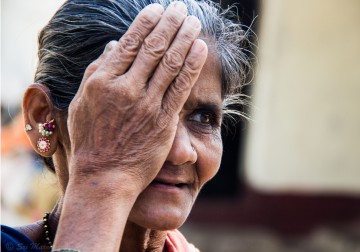In a new study from LVPEI, Debananda Padhy, Dr. Rohit C. Khanna, Dr. Srinivas Marmamula, and others identified the changing trends in major barriers to accessing eye care services in rural Telangana and Andhra Pradesh.
What stops a person from accessing eye care? Over a billion people around the world live with vision impairment (VI), 90% of whom live in low- and middle-income countries. A person with uncorrected VI faces several challenges, leading to a lower quality of life. In most cases, a simple correction or regular monitoring will restore or maintain vision. Despite increasing availability of services, there is insufficient eye care uptake in India. Southern India, with several well-developed eye care networks can give us insights into what barriers prevent people with VI from accessing care.
Access to eye care can have several barriers: distance, financial constraints, or lack of awareness. These barriers are often location-specific, having a greater role in rural areas, and as eye care networks increase and improve, can change with time. Identifying such changing trends requires population-based longitudinal studies measuring health-seeking behavior over time. The Andhra Pradesh Eye Disease Study (APEDS) was a large-scale, population-based longitudinal study by LVPEI in the Indian states of Telangana and Andhra Pradesh. The latest APEDS (APEDS III, 2012-2016) provides 15-year follow-up data on patients from APEDS I (1996-2000). This longitudinal approach can give insights into the changing trends in barriers to eye care uptake within a population.
Using data from APEDS III, a new paper published in the journal Eye, by Debananda Padhy, Drs. Rohit C. Khanna, Srinivas Marmamula, and others from LVPEI identified the major barriers to accessing eye care services in rural Telangana and Andhra Pradesh and how they changed with time. The study included 3,810 adult participants (30 years or older), among which 1,449 (38%) had VI. Nearly 90% of them (1,302 participants) noticed deterioration in their vision over the last five years, yet only 722 participants (50%) sought treatment. More than one-fourth of the participants (25.8%) did not consider vision loss to be a serious problem—despite having an eye problem.
The report notes an increase in the use of eye care services over the 15-odd years between the two studies. Participants were more likely to seek treatment if they were educated, had hypertension, or had VI due to reasons other than refractive errors or cataracts. Location was also a crucial factor in determining eye care uptake. Participants from Adilabad or Mahbubnagar districts of Telangana were over 2-3.5 times more likely to seek treatment for VI. This could be due to the presence of LVPEI secondary centers in these districts, which provide free eye care. The study shows that eye care availability—even free eye care—may not be enough.
‘We saw a significant decline in financial barriers, which suggests that people are more willing to spend on health care,’ comments Dr. Rohit C. Khanna, Network Director for Public Health at LVPEI and the corresponding author of this paper. ‘We also found that people from Mahbubnagar and Adilabad were more likely to access eyecare than in the past. It could be due to LVPEI starting eye care services in these regions and providing services for more than two decades.’
Citation
Padhy, D., Marmamula, S., Mettla, A. L., Pyda, G., Banerjee, S., Konegari, S., Chakrabarti, S., & Khanna, R. C. (2024). Changing trends in barriers to accessing eye care services in rural South India: results from the longitudinal Andhra Pradesh Eye Disease Study III (APEDS III) cohort. Eye (London, England), 38(11), 2209–2215. https://doi.org/10.1038/s41433-024-03155-5
Photo credit: Srinivas Marmamula.



